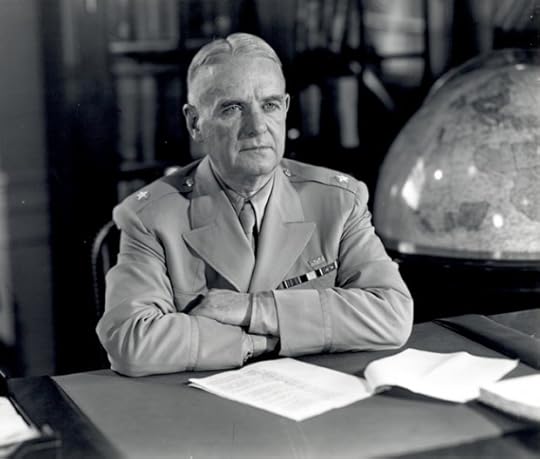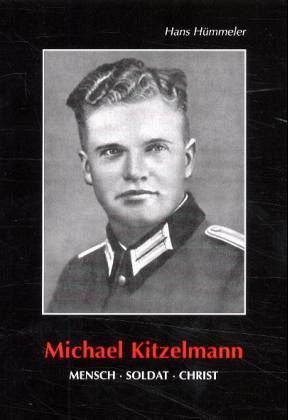Mark Scott Smith's Blog: Enemy in the Mirror, page 110
July 21, 2014
Wehrmacht Officer Who Condemned Atrocities Executed – June, 1942
Lt. Michael Kitzelmann was a Wehrmacht company commander at twenty-four and recipient of the Iron Cross 2nd Class for bravery and the Wound Badge in Gold for seven stays in field hospitals.
A devout Catholic born in Bavaria, Kitzelmann witnessed atrocities committed by the Einsatzgruppen (SS and Security Police killing squads) against the Russian population and Jews. Shocked, he began to openly criticize the war and criminal Nazi activities.
Kitzelmann was denounced by a comrade as he lay wounded in a hospital, court-martialed and executed in June 1942.
The post Wehrmacht Officer Who Condemned Atrocities Executed – June, 1942 appeared first on Enemy in the Mirror.
July 18, 2014
Awakening the Sleeping Giant – Yamamoto Apocrypha

Isoroku Yamamoto; Wikimedia Commons
After the Pearl Harbor attack, it has often been claimed that its chief architect Admiral Isoroku Yamamoto, Commander-in-chief of Imperial Japan’s Combined Fleet during World War II, uttered:
“I fear all we have done is to awaken a sleeping giant and fill him with a terrible resolve.”
Yamamoto studied at Harvard University (1919–1921) and was twice posted as a naval attaché in Washington, D.C. before the war. Fluent in English, he traveled extensively in the USA, studying customs and business practices. Yamamoto was no doubt familiar with potential American industrial might, and might well have had these thoughts.
However, there is no reliable documentation that he ever actually said this.
Nevertheless, that appears to be exactly what happened after mid-1942.
The post Awakening the Sleeping Giant – Yamamoto Apocrypha appeared first on Enemy in the Mirror.
July 16, 2014
First Battle of El Alamein – July 1942

http://samilitaryhistory.org/vo132jja...
The war was not going well for the Allies in the summer of 1942. The German Operation Barbarossa had advanced well into Russia and U-boats in the Western Atlantic were highly successful in preventing war materials from America from reaching Europe. Germany seemed to be in control of the Atlantic Ocean and Western Europe.
Control of El Alamein, in the North African desert 150 miles west of Cairo, was vital for the protection of the Suez Canal. If taken by General Erwin Rommel‘s Afrika Korps, the canal would give Germany a major psychological victory and close access to Middle Eastern oil.
In July 1942, the First Battle of El Alamein pitted Rommel’s tank corps (Panzerarmee Afrika) against the British Eighth Army (Britain, India, Australia, South Africa, New Zealand) commanded by General Claude Auchinleck. The battle, ending in a stalemate, nevertheless prevented a major advance of Axis forces into Egypt.
But Axis presence near El Alamein remained an ominous threat to the Suez Canal and it was clear that a Second Battle of El Alamein was looming.
The post First Battle of El Alamein – July 1942 appeared first on Enemy in the Mirror.
July 14, 2014
Bangka Island Massacre – February 1942
In February 1942 the cruise ship Vyner Brooke, carrying many injured servicemen and 64 Australian nurses was sunk by Japanese aircraft. Eleven nurses were lost in the attack, but the rest reached shore at Japanese-occupied Bangka Island, in the Dutch East Indies.
The ship’s officer and a small group of women and children went to the Japanese authorities to surrender while the nurses set up a shelter to care for the wounded. A contingent of Japanese soldiers returned, herded all ambulatory wounded away and shot them. A Japanese officer then ordered the remaining 22 nurses and one civilian woman to walk into the surf where they were machine-gunned. All but one nurse, left for dead, were killed. Wounded soldiers left on stretchers were then bayoneted and killed.
The wounded nurse Vivian Bullwinkel washed up on the beach and was left for dead. She evaded capture for 10 days, but was eventually caught and imprisoned. Surviving the war, she testified at a war crimes trial in Tokyo in 1947.
The post Bangka Island Massacre – February 1942 appeared first on Enemy in the Mirror.
July 11, 2014
Anti-Submarine Warfare – 1942
This May 1942 US Army Signal Corps/Hollywood propaganda film depicts a USAAF B-25 accurately bombing a U-boat off the Atlantic Coast. In reality, US anti-submarine tactics at this point in the war were dismal. Hundreds of merchant ships were sunk by an extremely effective U-Boat fleet in in the Battle of the Atlantic during the first half of 1942 before appropriate state-of-the-art US equipment was available and techniques such as depth charging (not bombing as shown in the film), convoy escorts, coordinated and sustained air and sea search and destroy operations were implemented.
The post Anti-Submarine Warfare – 1942 appeared first on Enemy in the Mirror.
July 9, 2014
Office of Strategic Services – June 1942

William J. Donovan; Wikimedia Commons
In 1941 US intelligence was gathered on an ad-hoc basis by the State, Treasury, Navy, and War Departments without coordination or central control. For the first half of 1942, most military intelligence came from the UK.
In July 1941 FDR appointed Colonel William J. Donovan as the “Co-ordinator of Information” and asked him to develop an intelligence service based on the British Secret Intelligence Service (MI6) and Special Operations Executive.
In June 1942, the Office of Strategic Services (OSS), the US WWII predecessor of the Central Intelligence Agency (CIA) was established by presidential order to collect and analyze strategic information required by the Joint Chiefs of Staff and conduct special operations (including propaganda, subversion and post-war planning) not assigned to other agencies.
During the War, the OSS supplied policy makers with facts and estimates, but never had jurisdiction over all foreign intelligence activities. The FBI retained responsibility for intelligence work in Latin America, and the Army and Navy continued to develop and rely on their own sources of intelligence.
For the duration of WWII, the OSS conducted multiple activities and missions, including espionage, sabotage, propaganda, organizing and coordinating European resistance groups and training anti-Japanese guerrillas.
The post Office of Strategic Services – June 1942 appeared first on Enemy in the Mirror.
July 7, 2014
Japanese View of the Battle of Midway
Excerpts from The Japanese Story of the Battle of Midway
Official Japanese action report of this engagement (A Translation)
Office of Naval Intelligence, United States Navy
June 1947
Existing Conditions and Trends
Subsequent to the beating he received in the Coral Sea on 7-8 May, the enemy was temporarily subdued, but by the end of May — by the time the Fleet was about to sortie from Hashira Jima — the enemy again began to show considerable life in all areas, particularly in the Australia area.
Situation in the Midway Area: Midway acts as a sentry for Hawaii. Its importance was further enhanced after the loss of Wake and it was apparent that the enemy was expediting the reinforcing of its defensive installations, its air base facilities, and other military installations as well as the personnel.
General Situation at Conclusion of Operations and the Commander’s Estimate Concerning It
Exceptional fighting was shown by all forces and all ships participating in this operation, and because of it, severe damages were inflicted on the enemy. At the same time, our losses numbered four carriers and the occupation of Midway was not carried out.
The enemy, however, having lost two of their powerful carriers and many of his air personnel, would undoubtedly be unable to effect any large-scale operation in the near future. It is believed that the enemy will surely strike back at some time, and every precaution should be taken against this.
Through this operation, there are some vital lessons learned in aircraft carrier warfare, which should be kept alive. These include such items as the reinforcements of searches for the enemy, flexibility of assembling and dispersing, and the speedy take-offs of friendly aircraft when the enemy is sighted.
Recognition of Meritorius Actions
1. The men of the plane units which succeeded in severely damaging enemy military installations on Sand and Eastern Islands in spite of persistent enemy fighters and vicious AA fire, are highly commended.
2. The action of the men of CarDiv 2 (less the Soryu), in succeeding to sink (or severely damage) two of the new and powerful enemy carriers in spite of the fact that the enemy had gained control of the air, must be commended highly. These men well represented our entire forces. The men of the Hiryu air unit (including 1st class P.O. (Air) Yamamoto from the Kaga and 3rd class P.O. (Air) Bando also from the Kaga) who sacrificed themselves by flying into territory which meant sure death and carried out “body crash” tactics, is particularly cited as being exceptional even in the traditionally glorious history of the Imperial Navy.
The post Japanese View of the Battle of Midway appeared first on Enemy in the Mirror.
July 4, 2014
United We Stand: July 1942:

Wikimedia Commons
In July 1942, seven months after the attack on Pearl Harbor, 500 magazines nationwide featured the American flag on their covers.
Adopting the slogan “United We Stand,” American publications displayed the American flag to promote national unity, rally support for the war, and celebrate Independence Day.
The post United We Stand: July 1942: appeared first on Enemy in the Mirror.
July 2, 2014
US Navy Torpedo Bombers at Midway
At 06:20 on June 4. 1942, Japanese carrier aircraft bombed and heavily damaged the U.S. base at Midway. However, American bombers were still able to refuel and attack the Japanese invasion force, and most of Midway’s land-based defenses were intact. Having taken off prior to the Japanese attack, American bombers based on Midway made several attacks on the Japanese carrier fleet.
At 07:15, Admiral Chuichi Nagumo ordered his reserve planes to be re-armed with contact-fused general purpose bombs for use against land targets. At 07:40 a Japanese scout plane reported a large American naval force of uncertain composition to the east. Admiral Nagumo reversed his order to re-arm the bombers and demanded information regarding the composition of the American force. However, Nagumo’s opportunity to attack the American ships was now limited by the imminent return of his Midway strike force that needed to land promptly or ditch into the sea. Additionally, constant flight deck activity associated with combat air patrol operations gave Nagumo no opportunity to position his reserve planes on the flight deck for launching.
US Navy Admiral Raymond Spruance, judging the need for an immediate attack urgent, launched several uncoordinated groups of fighters, bombers, and torpedo bombers toward the target. But the American carrier aircraft had difficulty locating the Japanese carriers. On incorrect headings and low on fuel, many turned back or ditched in the sea.
Torpedo Squadron VT-8 from the aircraft carrier USS Hornet, led by LTC John C. Waldron, broke formation and followed the correct heading. Waldron’s Grumman F-4 Wildcat fighter escorts, low on fuel had to turn back, leaving Squadron VT-8’s obsolete, slow, under-armed Douglas TBD Devastators unescorted.
At 0920 Waldron’s squadron sighted the enemy carriers and began the attack, followed by Torpedo Squadron VT-6 led by LTC Eugene E. Lindsey and VT-3 led by LTC Lance E. Massey from the USS Enterprise, also without fighter escort. A few TBD Devastators managed to fly close enough to their targets to drop torpedoes and strafe the enemy ships, forcing the Japanese carriers to make sharp evasive maneuvers. But all of their torpedoes either missed or failed to explode.
Lacrimosa - Requiem Mass in D minor (K. 626) by Wolfgang Amadeus Mozart
http://www.enemyinmirror.com/wp-content/uploads/2014/07/lacrimosa-2.mp3
Without fighter escort, all fifteen TBD Devastators of VT-8, 10/14 of VT-6 and 10/12 of VT-3 were shot down by Japanese Mitsubishi A6M2 Zeros without being able to inflict any damage. The tragic loss of these torpedo squadrons without any hits, nevertheless achieved three important results that facilitated the subsequent successful American air attack on the Japanese carriers:
Japanese carriers were thrown off balance, preventing them from launching an effective counterstrike
Japanese combat air patrols were pulled out of position
Many Japanese Zeros ran low on ammunition and fuel
The post US Navy Torpedo Bombers at Midway appeared first on Enemy in the Mirror.
June 30, 2014
Battle of Midway Island – June 1942

Battle of Midway; Wikimedia Commons
On June 4, 1942 the US Navy turned the tide of the Pacific War against the previously all-powerful Imperial Japanese fleet. With information gained from cracking the Japanese PURPLE code, the U.S. Navy was lying in wait when the Japanese initiated their attack on Midway Island with the intention to surprise and destroy the US aircraft carriers that had escaped the attack on Pearl Harbor.
In a relatively short air battle between aircraft carriers, the Imperial Japanese Navy lost the aircraft carriers Akagi, Kaga, Soryu, and Hiryu, the heavy cruiser Mikuma, 322 aircraft and over five thousand sailors.
Although the US Navy lost 147 aircraft (including the tragic loss of 35/41 obsolete Douglas TBD ‘Devastator’ torpedo bombers) and 300 seamen in the battle, only one aircraft carrier, the Yorktown, was sunk by the Japanese.
This resounding victory at Midway seriously diminished the power of the Imperial Japanese Navy and moved the Allies into an unrelenting offensive position for the duration of the Pacific War.
The post Battle of Midway Island – June 1942 appeared first on Enemy in the Mirror.
Enemy in the Mirror
I began by posting events around the turn This website www.enemyinmirror.com explores the consciousness, diplomacy, emotion, prejudice and psychology of 20th Century America and her enemies in wartime.
I began by posting events around the turn of the 20th century as I was researching my first novel about the Pacific War. I continued through WWII for my second novel about the Battle of the Atlantic. Now I am beginning to look at the Cold War as I gather information for my next novel about the Korean War. ...more
- Mark Scott Smith's profile
- 7 followers






